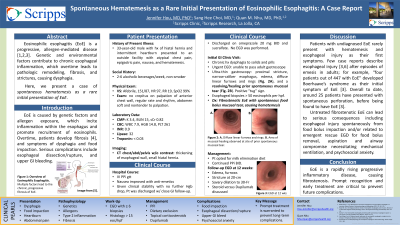Sunday Poster Session
Category: Esophagus
P0493 - Spontaneous Hematemesis as a Rare Initial Presentation of Eosinophilic Esophagitis: A Case Report
Sunday, October 22, 2023
3:30 PM - 7:00 PM PT
Location: Exhibit Hall

Has Audio

Jennifer Hou, MD, PhD
Scripps Clinic/Scripps Green
La Jolla, CA
Presenting Author(s)
Jennifer Hou, MD, PhD1, Sang Hee K. Choi, MD2, Quan M.. Nhu, MD, PhD3
1Scripps Clinic/Scripps Green, La Jolla, CA; 2Scripps Clinic/Scripps Green Hospital, La Jolla, CA; 3Scripps Clinic & Scripps Research Institute, La Jolla, CA
Introduction: Eosinophilic esophagitis (EoE) is a progressive, allergen-mediated chronic disease that results in fibrostenotic EoE. EoE patients present with symptoms of esophageal dysfunction, e.g., dysphagia and food impaction. More serious and rare EoE complications may include esophageal dissection, esophageal rupture, and upper gastrointestinal bleeding. Herein, we present a case of spontaneous hematemesis in a healthy young male as a rare initial presentation of EoE.
Case Description/Methods: Patient is a healthy 33-year-old male with intermittent heartburn who presented to the emergency room (ER) elsewhere with acute onset of intense heartburn, nausea without vomiting or retching, and several episodes of hematemesis with bright red blood after ingesting food. Lab studies showed stable hemoglobin 13.1 g/dL, platelet 181 K/mcL and INR 1.0. Computed tomography imaging was unrevealing except for distal esophageal wall thickening. Given clinical stability, patient was treated empirically with a proton-pump inhibitor (PPi), fluid resuscitated, and discharged with urgent outpatient evaluation.
Further history obtained in the clinic revealed chronic dysphagia to solid food and pills. Esophagogastroduodenoscopy (EGD) at ~2 weeks after the ER visit showed a severely narrowed proximal esophagus. Ultra-thin gastroscopy demonstrated a narrow-caliber esophagus with a proximal stricture, edema, diffuse linear furrows, and diffuse esophageal rings. Careful inspection showed an area of healing linear mucosal tear proximally, which likely represents recent spontaneous esophageal stretching and injury, causing hematemesis. Esophageal biopsies showed >50 eosinophils/hpf, confirming the diagnosis of EoE. Post-EGD, he was managed with high-dose PPi twice daily and milk/dairy elimination per patient’s preference. On follow-up EGD, endoscopic severity persisted with no histologic response. He was treated with Savary dilation to 30-French. Discussions of step-up EoE therapy with topical corticosteroids or biologic therapy are ongoing.
Discussion: Spontaneous hematemesis from mucosal injury related to food bolus dilation of a narrowed esophagus is a rare complication of fibrostenotic EoE. Our patient received a new diagnosis of EoE, with spontaneous hematemesis as his initial presentation, having had previously unrecognized symptoms of chronic dysphagia. EoE is rising rapidly in both incidence and prevalence. This case highlights the importance of prompt recognition and treatment of EoE to prevent future complications.
Disclosures:
Jennifer Hou, MD, PhD1, Sang Hee K. Choi, MD2, Quan M.. Nhu, MD, PhD3. P0493 - Spontaneous Hematemesis as a Rare Initial Presentation of Eosinophilic Esophagitis: A Case Report, ACG 2023 Annual Scientific Meeting Abstracts. Vancouver, BC, Canada: American College of Gastroenterology.
1Scripps Clinic/Scripps Green, La Jolla, CA; 2Scripps Clinic/Scripps Green Hospital, La Jolla, CA; 3Scripps Clinic & Scripps Research Institute, La Jolla, CA
Introduction: Eosinophilic esophagitis (EoE) is a progressive, allergen-mediated chronic disease that results in fibrostenotic EoE. EoE patients present with symptoms of esophageal dysfunction, e.g., dysphagia and food impaction. More serious and rare EoE complications may include esophageal dissection, esophageal rupture, and upper gastrointestinal bleeding. Herein, we present a case of spontaneous hematemesis in a healthy young male as a rare initial presentation of EoE.
Case Description/Methods: Patient is a healthy 33-year-old male with intermittent heartburn who presented to the emergency room (ER) elsewhere with acute onset of intense heartburn, nausea without vomiting or retching, and several episodes of hematemesis with bright red blood after ingesting food. Lab studies showed stable hemoglobin 13.1 g/dL, platelet 181 K/mcL and INR 1.0. Computed tomography imaging was unrevealing except for distal esophageal wall thickening. Given clinical stability, patient was treated empirically with a proton-pump inhibitor (PPi), fluid resuscitated, and discharged with urgent outpatient evaluation.
Further history obtained in the clinic revealed chronic dysphagia to solid food and pills. Esophagogastroduodenoscopy (EGD) at ~2 weeks after the ER visit showed a severely narrowed proximal esophagus. Ultra-thin gastroscopy demonstrated a narrow-caliber esophagus with a proximal stricture, edema, diffuse linear furrows, and diffuse esophageal rings. Careful inspection showed an area of healing linear mucosal tear proximally, which likely represents recent spontaneous esophageal stretching and injury, causing hematemesis. Esophageal biopsies showed >50 eosinophils/hpf, confirming the diagnosis of EoE. Post-EGD, he was managed with high-dose PPi twice daily and milk/dairy elimination per patient’s preference. On follow-up EGD, endoscopic severity persisted with no histologic response. He was treated with Savary dilation to 30-French. Discussions of step-up EoE therapy with topical corticosteroids or biologic therapy are ongoing.
Discussion: Spontaneous hematemesis from mucosal injury related to food bolus dilation of a narrowed esophagus is a rare complication of fibrostenotic EoE. Our patient received a new diagnosis of EoE, with spontaneous hematemesis as his initial presentation, having had previously unrecognized symptoms of chronic dysphagia. EoE is rising rapidly in both incidence and prevalence. This case highlights the importance of prompt recognition and treatment of EoE to prevent future complications.
Disclosures:
Jennifer Hou indicated no relevant financial relationships.
Sang Hee Choi indicated no relevant financial relationships.
Quan Nhu: Regeneron – Advisory Committee/Board Member, Speakers Bureau. Sanofi – Advisory Committee/Board Member, Speakers Bureau. Takeda – Advisory Committee/Board Member.
Jennifer Hou, MD, PhD1, Sang Hee K. Choi, MD2, Quan M.. Nhu, MD, PhD3. P0493 - Spontaneous Hematemesis as a Rare Initial Presentation of Eosinophilic Esophagitis: A Case Report, ACG 2023 Annual Scientific Meeting Abstracts. Vancouver, BC, Canada: American College of Gastroenterology.

